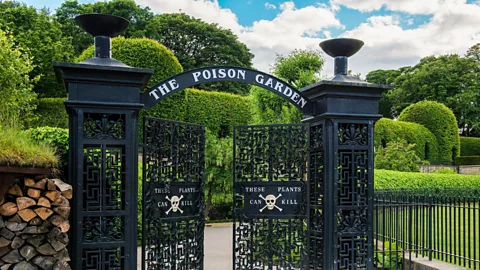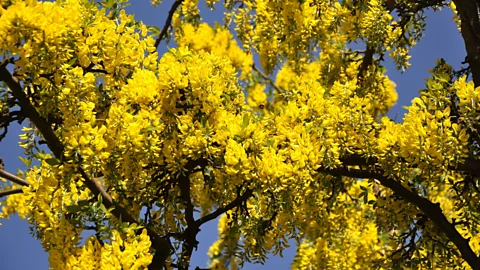The UK's deadliest garden

The Poison Garden at the Alnwick Garden in Northumberland, England, is home to more than 100 toxic, intoxicating and narcotic plants. And it's open to public.
The sign on the black iron gate says, "These plants can kill", and it's emblazoned with a skull and crossbones for good measure. The warning isn't a joke – the plot sealed off behind these black iron bars is the deadliest garden in the world. And it's open to the public.
Established in 2005, the Poison Garden at the Alnwick Garden in Northumberland, England, is home to more than 100 toxic, intoxicating and narcotic plants. "Before visitors are allowed to enter, they must have a safety briefing," said Dean Smith, a guide at the Poison Garden. Visitors are instructed that they're not allowed to touch, taste or smell anything – nevertheless, as the website notes, guests have still occasionally fainted from inhaling toxic fumes as they walk through.
One of the dangerous plants cultivated here is monkshood, or wolf's bane, which contains aconitine, a neurotoxin and cardio toxin. But that's not the worst one: "Probably the most poisonous plant we actually have here is ricin [which contains the toxin ricin] better known as the castor bean or castor oil plant," Smith said. "The Guinness Book of World Records considers that to be the world's most poisonous plant."
Surprisingly, a lot of the things that grow in the garden are quite common. "Many of the plants in here do grow wild in the UK, and most of the plants are alarmingly easy to cultivate," Smith said. Even popular home-garden bushes like rhododendrons are accounted for here. Those leaves contain grayanotoxin which will attack a person's nervous system if eaten. "You're not likely to eat the leaves, though, because they taste disgusting," Smith said reassuringly.
And then there's the laburnum tree, the second most poisonous tree in the UK (only the yew tree is more dangerous). Many people have them around their homes because of their beautiful yellow flowers, but they contain a poison called cytisine. "The tree is so poisonous," said Smith, "that if one of the branches was to fall to the floor, lay there for several months and the dog later comes along, picks it up to hold as a stick on a walk, chances are the dog won't finish the walk. It's that poisonous."
Poison plants don't only direct their venom at humans and dogs, though. As Smith explained, if enough rhododendrons grow near each other, they'll poison the soil – making it so that the only things that can grow there are other rhododendrons. And if bees gather honey exclusively from rhododendrons, the liquid takes on a red colour and, in small doses, hallucinogenic properties. "But larger doses would be fatal," he warned.
Some plants don't have to be eaten, touched, smelled or turned into psychedelics to kill you. There's one plant in the garden that can kill you just by trimming it. The leaves of the Prunus laurocerasus (also known as the cherry laurel or English laurel) contain two components (cyanogenic glycosides and cyanide ions) that, separately, won't harm you. But if an animal was to mash up the leaves by chewing them – or if a human was to take a hedge cutter to them – they produce cyanide gas.
"Normally you're in this outside, well-ventilated space, and on a windy day, it's probably not going to be an issue," he said. "Until you put the cuttings into the boot of your car to take to the tip [the garbage dump] – you're now in a confined space [with] poor ventilation and cyanide gas."
Hellebores, like the Christmas Rose, are another dangerously common plant here. The root has a cardiotoxin that will stop your heart, and the sap has a strong skin irritant. So always wear gloves, and Smith warned, don't remove them by pulling them off with your teeth.
That's something the gardeners here would never do. As head gardener Robert Ternent said, the staff here take a variety of safety steps. "Some of the beds, you don't have to take any precautions at all, whereas you'll get to, like, the giant hogweed bed and then you have a full hazmat suit on, facemask, gloves."
Gardener Amy Thorp is not rattled. "I don't think it concerns me because I feel like we're in their spaces," she said. "A lot of these plants, I think, might have been there before we came along. So, it's up to us to learn and educate ourselves about all of their uses, because a lot of the plants in here are used for good. They're not all bad."

In fact, some of the deadliest plants here are the sources of great cures, like the yew, which is used in the treatment of breast cancer. And periwinkle is also double-edged: its ingredients can be fatal, but if processed correctly, it produces beneficial medicines.
Perhaps not surprisingly, the garden is part of a drugs education programme. As Claire Mitchell, head of community and education, explained, "The north-east of England has the highest rates of drug deaths in England and Wales. Something needs to be done in terms of actually getting information to young people out there. So, the drugs education programme stems from the Poison Garden tours, where we do have drug plants, and the whole idea behind it is to prevent drug-related harm."
Indeed, the garden cultivates "the ABC of drugs", as Smith put it: they grow opium poppies (a Class A drug), cannabis (a Class B drug) and catha edulis, commonly known as 'khat' (a Class C drug). But visitors shouldn't get any ideas. As Ternent explained, the staff at the Poison Garden is mandated by to law to meticulously monitor, count and file reports on their drug plants – and then submit proof that they've destroyed them at the end of every season.
This video is part of BBC Reel's Ultimate World playlist.
---
Join more than three million BBC Travel fans by liking us on Facebook, or follow us on Twitter and Instagram.
If you liked this story, sign up for the weekly bbc.com features newsletter called "The Essential List". A handpicked selection of stories from BBC Future, Culture, Worklife and Travel, delivered to your inbox every Friday.
